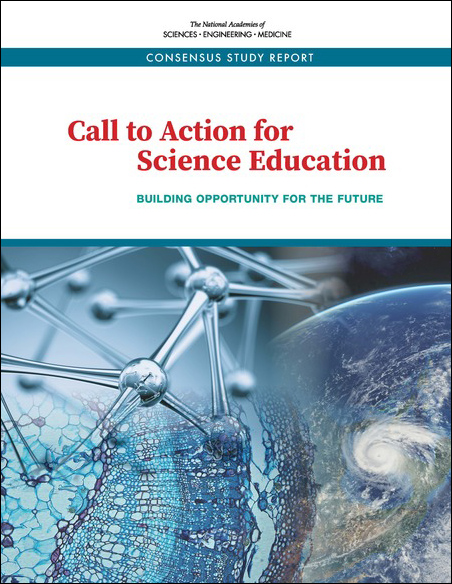Science Education Should Be National Priority, Says New Report
This post is adapted from a National Academies press release:
 The White House, with leadership from the Office of Science and Technology Policy, should encourage federal agencies, state and local governments, and others to focus resources on increasing the quality and accessibility of science education — from kindergarten through the end of a postsecondary degree (K-16) — says a new report from the National Academies of Sciences, Engineering, and Medicine.
The White House, with leadership from the Office of Science and Technology Policy, should encourage federal agencies, state and local governments, and others to focus resources on increasing the quality and accessibility of science education — from kindergarten through the end of a postsecondary degree (K-16) — says a new report from the National Academies of Sciences, Engineering, and Medicine.
Call to Action for Science Education: Building Opportunity for the Future says science knowledge and scientific thinking are essential for democracy and the future science, technology, engineering, and mathematics (STEM) workforce, yet science education is not the national priority it needs to be. High-quality science education gives students the opportunity to carry out investigations, analyze data, draw conclusions, and communicate results — skills that are increasingly valuable in today’s workforce and society overall.
Only 22% of American high school graduates are proficient in science, and the average elementary classroom devotes less than 20 minutes per day to science; 69% of elementary teachers say they are not well prepared to teach science. States and local communities are not delivering high-quality science education in equal measure to all — students of color and students experiencing poverty are particularly unlikely to have high-quality science education throughout K-16.
“Far too many students, from kindergarten classrooms to college lecture halls, are learning science by reading about it in a textbook, by listening passively, or memorizing disconnected facts. They’re left asking, ‘what does science have to do with my life?’” said Margaret Honey, President and CEO of the New York Hall of Science and chair of the committee that wrote the report. “Our report proposes a vision for the future of science education in which all students experience the joy, beauty, and power of science in the classroom and throughout their lives.”
The report says communities need to provide time, materials, and resources to schools to support science education, and having a well-prepared, diverse teaching workforce across K-16 is essential. Students need clear pathways that support them through science education in college. Support from policy makers is necessary to support communities in making these changes.
Elevating the Status of Science Education
The report says Congress should include science as an indicator of academic achievement in its next reauthorization of the Elementary and Secondary Education Act — and a system of assessments and indicators should provide information about the progress of schools, districts, and states. Accountability for science education, however, should not be based on single tests, but rather focus on students gaining conceptual understanding.
State departments of education should also act to include science in their accountability systems, supporting classroom instruction and tracking the availability of learning opportunities. National stakeholders in STEM education — including business, philanthropy, and nonprofits — should coordinate their advocacy, with particular attention to addressing disparities in opportunity.
Local and Regional Alliances for STEM
Leaders of K-12 school systems and postsecondary schools should form “Alliances for STEM Opportunity.” These alliances should develop evidence-based visions and plans for improving STEM education in their areas, with specific attention to addressing disparities and high-quality learning opportunities. The federal government, philanthropic organizations, and business and industry should provide funding to these alliances to support their work — first targeting communities where a significant number of students live in poverty.
Documenting Progress
The federal government should develop an annual “STEM Opportunity in the States” report card, to document K-16 STEM education in each state and territory, and track equity of opportunity. States should develop their own plans for providing equitable STEM education, including STEM opportunity maps that track disparities and progress made.
The study — undertaken by the Committee on Call to Action for Science Education — was sponsored by the Carnegie Corporation of New York and National Academy of Sciences’ W.K. Kellogg Fund. The National Academies are private, nonprofit institutions that provide independent, objective analysis and advice to the nation to solve complex problems and inform public policy decisions related to science, technology, and medicine. They operate under an 1863 congressional charter to the National Academy of Sciences, signed by President Lincoln.

